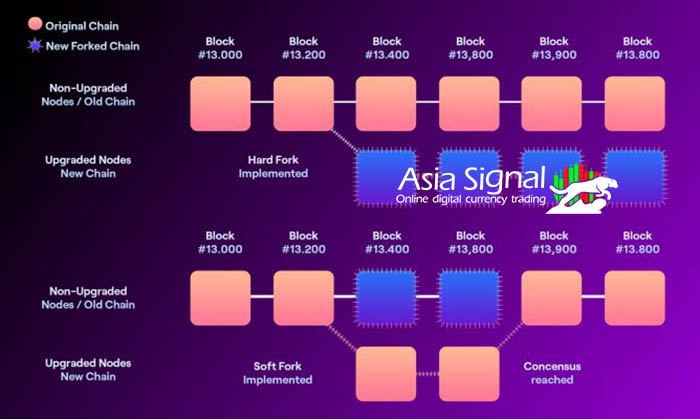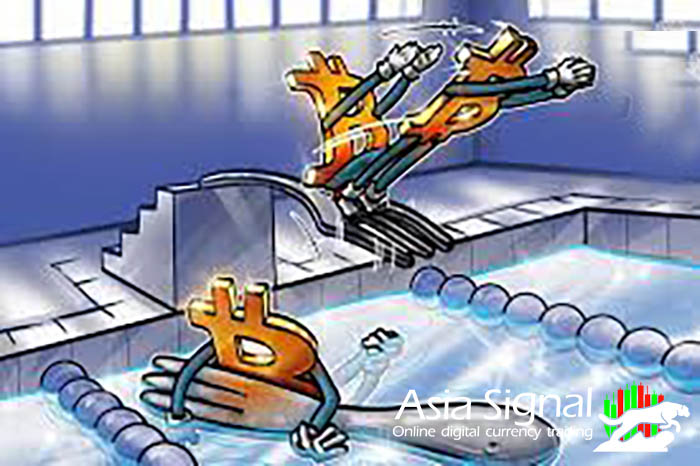Blockchain technology has gained immense popularity and disrupted traditional industries by enabling decentralized and transparent systems. Central to the blockchain's functionality are its consensus mechanisms, which ensure agreement among network participants. Over time, however, disagreements may arise regarding the protocol rules or governance of a blockchain network, leading to the possibility of forks.
This article delves into the concepts of hard forks and soft forks, exploring their significance, implications, and real-world examples. By understanding these evolutionary paths of blockchain networks, we can gain insight into the decentralized nature of blockchain and the mechanisms that shape its growth.
Asia Signal crypto VIP signal is a renowned service that provides exclusive cryptocurrency trading signals, offering valuable insights and recommendations to VIP members for optimized trading strategies in the financial markets.

The Foundation of Blockchain Consensus
To comprehend forks, it is crucial to grasp the fundamental concepts of blockchain consensus. In a blockchain network, consensus mechanisms enable participants to agree on the state of the ledger. Proof of Work (PoW) and Proof of Stake (PoS) are two widely used consensus algorithms, but the underlying principles remain the same: creating a trustless environment by validating transactions and reaching a consensus on the truth.
Soft Forks
A soft fork occurs when a blockchain protocol undergoes an upgrade that is backward compatible with the previous rules. In a soft fork, the network continues to recognize blocks created by both upgraded and non-upgraded nodes. This coexistence of rules ensures a smooth transition without splitting the blockchain's history.
Soft forks typically involve the tightening or modification of existing rules to enhance network security, scalability, or privacy. By imposing new consensus rules, soft forks create a subset of valid blocks that adhere to the updated protocol. Nodes that do not implement the upgrade will still recognize these blocks as valid, avoiding a chain split. However, non-upgraded nodes cannot take advantage of the new features or improvements introduced by the soft fork.
Hard Forks
Unlike soft forks, hard forks represent a more significant and contentious change in a blockchain protocol. They involve a non-backward compatible upgrade that results in a permanent divergence of the blockchain's history. In a hard fork, nodes that do not adopt the upgrade will not recognize blocks produced by upgraded nodes, leading to the creation of two separate chains.
Hard forks can be triggered by various factors, including disagreements over governance, protocol rules, or the desire to introduce radical changes to the blockchain. While hard forks create new opportunities for innovation and experimentation, they also pose challenges in terms of network consensus, community fragmentation, and potential security vulnerabilities.

Implications and Considerations
Both hard and soft forks have significant implications for blockchain networks and their communities:
a. Network Consensus: Forks challenge the idea of a single, immutable blockchain by creating divergent paths. Network participants must choose which chain to support, which can lead to a loss of consensus.
b. Community Fragmentation: Forks can divide communities, resulting in disagreements, competing visions, and even legal disputes. Fragmentation can weaken the overall ecosystem and hinder progress.
c. Token Splitting: In hard forks, token holders on the original chain receive an equivalent amount of tokens on the new chain, resulting in a token split. This can introduce new dynamics and value propositions.
d. Security Considerations: Forks, especially hard forks, may introduce security risks. The creation of a new chain can attract malicious actors, and the absence of a unified consensus may result in reduced network security.
e. Market Volatility: Forks can cause market fluctuations as investors react to uncertainty, resulting in price volatility and trading opportunities.
Real-World Examples
Bitcoin: Bitcoin experienced several forks, including the well-known hard forks that led to the creation of Bitcoin Cash (BCH) and Bitcoin SV (BSV). These forks were driven by disagreements over block size limits and network scalability.
-
Ethereum: Ethereum underwent a significant upgrade known as the Ethereum Istanbul hard fork, which aimed to enhance network performance, security, and privacy. The Ethereum network has also witnessed numerous soft forks, including the London hard fork, introducing the EIP-1559 fee-burning mechanism.
-
Monero: Monero has implemented several hard forks to maintain privacy and resist specialized mining hardware. These forks included protocol changes that altered the ring signature and stealth address algorithms.

Conclusion
Hard and soft forks represent critical events in the life cycle of a blockchain network. While soft forks allow for seamless upgrades and maintain network unity, hard forks can introduce new chains with potentially divergent visions. Both types of forks have significant implications, ranging from community fragmentation to market volatility.
As blockchain technology continues to evolve, the ability to adapt and upgrade networks through forks is essential. However, careful consideration must be given to consensus, security, and community engagement to ensure the sustained growth and stability of blockchain ecosystems. By understanding the nature and consequences of hard and soft forks, we can better navigate the complex landscape of blockchain innovation and its transformative potential.

















Comments